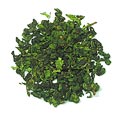Oolong 烏龍 is a traditional Chinese tea. In contrast to oolong tea, green tea is an un-oxidized tea, and black tea is a fully-oxidized tea. The oxidation level of oolong tea gives it more flavor than green tea, but results in a lighter brew than black tea. Although oo-long has a taste more akin to green tea than to black tea, it does not have the stridently grassy vegetal notes that typify green tea. The best Oolong has a nuanced flavor profile. It should be brewed strong and bitter, yet leave one's mouth with a faintly sweet aftertaste.
The term "oolong" means "black dragon" (or more literally "raven dragon") in Chinese; various legends describe the origin of this curious name. In one legend, the owner of a tea plantation was scared away from his drying tea leaves by the appearance of a black serpent; when he cautiously returned several days later, the leaves had been oxidized by the sun and gave a delightful brew. Another tale tells of a man named Wu Liang (later corrupted to Wu Long, or Oolong) who discovered oolong tea by accident when he was distracted by a deer after a hard day's tea-picking, and by the time he remembered about the tea it had already started to oxidize. Others say that the tea is called "oolong" because the leaves look like little black dragons that wake when you pour hot water on them.
Oolong tea is mainly produced in China and Taiwan, but other countries like Vietnam, Thailand, and Sri Lanka also produce a small amount of oolong. Famous examples of Oolong from China are Tie Kuan Yin (鐵觀音), Shui Xian, Dan Chong (单枞), and so on. While some famous Oolong from Taiwan and Thailand will be Cui Yu Oolong (翠玉乌龙), Dong Ding Oolong (冻顶乌龙), Ruan Zhi Oolong (软枝乌龙), and so on.
The term "oolong" means "black dragon" (or more literally "raven dragon") in Chinese; various legends describe the origin of this curious name. In one legend, the owner of a tea plantation was scared away from his drying tea leaves by the appearance of a black serpent; when he cautiously returned several days later, the leaves had been oxidized by the sun and gave a delightful brew. Another tale tells of a man named Wu Liang (later corrupted to Wu Long, or Oolong) who discovered oolong tea by accident when he was distracted by a deer after a hard day's tea-picking, and by the time he remembered about the tea it had already started to oxidize. Others say that the tea is called "oolong" because the leaves look like little black dragons that wake when you pour hot water on them.
Oolong tea is mainly produced in China and Taiwan, but other countries like Vietnam, Thailand, and Sri Lanka also produce a small amount of oolong. Famous examples of Oolong from China are Tie Kuan Yin (鐵觀音), Shui Xian, Dan Chong (单枞), and so on. While some famous Oolong from Taiwan and Thailand will be Cui Yu Oolong (翠玉乌龙), Dong Ding Oolong (冻顶乌龙), Ruan Zhi Oolong (软枝乌龙), and so on.

Example of Oolong- Tie Kuan Yin (鐵觀音)
Processing of Oolong
Oolong tea undergoes a few delicate processes in order to produce the unique aroma and taste. Typical Oolong tea is processed according to the following steps:
- Wilting (萎凋)- Sun dry or air dry to remove some moisture.
- Yaoqing (摇青)- To bruise the edge of the tea leaf to create more contacting surface for oxidization.
- Rouqing (揉青)- The tea leaves are tumbled for the next stage.
- Shaqing (杀青)- Process to stop further oxidation. Depending on the quality of the leaves, they will be dried in a large pan over heat and stirred by hand (for premium tea) or by machinery.
- Cooling.
- Drying- To remove excessive moisture.
- Grading.
- Packaging.


No comments:
Post a Comment